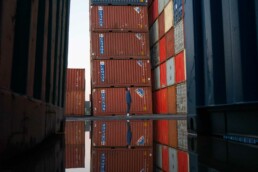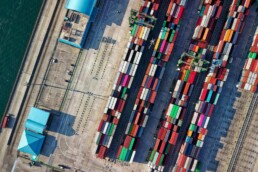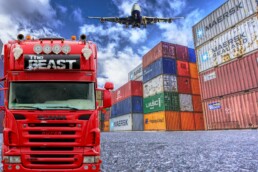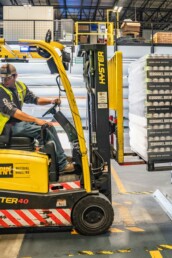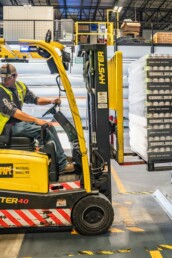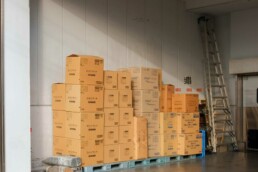Navigating Supply Chain Volatility in 2023 - Insights and Strategies
Navigating Supply Chain Volatility in 2023
In an era marked by continuous disruptions and labor negotiations, the 2022 Council of Supply Chain Management Professionals (CSCMP) State of Logistics report revealed a startling fact: United States business logistics costs accounted for 9.1% of the GDP. Amid this backdrop, the logistics industry witnessed a significant upturn even as the national economy grappled with uncertainties. Supply chain volatility in 2023 is a huge factor for the economy both for consumers and vendors. Here is what you need to know.

Root Causes of Supply Chain Volatility in 2023
The session, moderated by Kevin Smith, the president, and CEO of Sustainable Supply Chain Consulting and CSCMP chairman of the board, explored the root causes of this volatility. Smith cited the demise of LTL carrier Yellow Corp., the UPS-Teamsters negotiations, and the ongoing talks between the United Auto Workers and the ‘Big Three’ automakers, among other factors. These factors have collectively contributed to the turbulence experienced in the industry.
Chaos in the Supply Chain
Paul Bingham, the director of transportation consulting for S&P Global Market Intelligence, underlined that the 9.1% logistics GDP figure reflects the amalgamation of ongoing disruptions, including inflation and the Federal Reserve’s efforts to combat it. These disruptions span various aspects of business operations, from labor challenges to substantial declines in transportation rates and the recent surge in fuel prices. These elements have significantly impacted the overall performance of the logistics sector.
Rising Costs and Uncertainty
Interest rates, the cost of capital, and inventory carrying costs have surged to their highest levels in years for many industry stakeholders. These factors play a crucial role in decision-making processes, affecting inventory policies and both consumer and business-related choices. This, in turn, has contributed to the freight recession experienced throughout the year. The prospects of a swift recovery are strongly influenced by interest rates and the costs of capital across the entire economy.
Shippers’ Perspective
From a shipper’s perspective, Chris Jackson, the vice president of operations & IT for Chevron North America, holds a cautious outlook. He anticipates that volatility is here to stay, and there are no quick fixes in sight. According to Jackson, the key to managing this volatility is to position your company as a shipper of choice. While this may sound straightforward, it involves a multitude of tasks, including a deep understanding of your freight, including its classes, weights, and dimensional factors.
The Role of Resilience
Jennifer Kobus, the vice president of transportation & logistics for Ulta Beauty, emphasized the need for resilience and strong partner relationships when navigating supply chain volatility. She stated, “These attributes are extremely critical. We have been dealing with volatility for the last few years, which requires resilience. The name of the game is really about contingency planning. It is absolutely critical. We have learned that the ability to be resilient and adapt quickly necessitates a well-structured set of plans. This includes establishing strategic partnerships and collaborative relationships with the carriers you work with, beyond the annual RFP process.”
Potential for Stability
While supply chain volatility remains a constant challenge, Greg Javor, the senior vice president of global supply chain operations for Mattel Inc., envisions a potential return to pre-pandemic levels, as rates approach their pre-pandemic norms. Javor emphasized that, in most cases, annual bidding is no longer sufficient, and ongoing adaptation is necessary, given the unpredictable nature of the industry.
3PL Sector Insights
Penske Senior Vice President of Sales and Solutions Andy Moses, representing the 3PL sector, emphasized that volatility drives close collaboration and serves as a necessary component of achieving positive outcomes.
Market Dynamics
From a market perspective, Moses views the economy as a “sleeping giant” of sorts. “When I look at the underlying costs of transportation, they are not dropping,” he said. “Rates may have dropped a bit, but costs have not dropped. Equipment, labor, insurance, in particular, and rates might have dropped a bit. Any 4% to 5% increase in activity is going to be felt quickly. I do think there is more volatility coming with any help at all from the economy.”
2023 eCommerce Sustainability: Best Practices for a Greener Future
With the growing concern for our planet’s well-being, it’s crucial for online businesses to adopt sustainable practices that not only drive profits but also contribute to a greener future. In this blog post, we’ll delve into the best eCommerce sustainability practices for 2023 and beyond, helping you thrive while being environmentally responsible.
Read More…
In the face of supply chain volatility, staying agile, knowing your business inside out, and forming strong partnerships emerge as the tools to weather the storm. The path ahead is uncertain, but with the right strategies, businesses can thrive amidst the chaos. Supply Chain Volatility 2023 remains a challenge, but one that can be overcome with resilience and adaptability.
Partner with Falcon and let us help you master your supply chain.
Let’s Talk!
Global E-commerce Market Growth to Reach $9.3 Trillion by 2027
Unlocking the Potential: Global E-commerce Market Growth to Reach $9.3 Trillion by 2027
The global e-commerce market is undergoing a transformation driven by e-commerce-as-a-service companies and online marketplaces. This democratization of e-commerce, led by giants like Shopify, Amazon, and Alibaba, is making it accessible to all. With improved technology, evolving delivery services, and increased internet adoption, the global e-commerce market is projected to surge to an impressive $9.3 trillion by 2027, exhibiting a robust compound annual growth rate (CAGR) of 9.5% from 2022, as per GlobalData, a prominent data and analytics authority.
GlobalData’s recent report on “E-commerce” reveals a remarkable journey, with global e-commerce transactions surging from $2.5 trillion in 2016 to a staggering $5.9 trillion in 2022, boasting a CAGR of 15%.
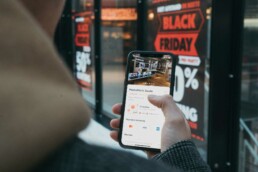
The Geography of Global E-commerce
Aisha U-K Umaru, a thematic intelligence analyst at GlobalData, highlights that while the ecommerce industry is expanding worldwide, significant geographical variations are apparent. Presently, the United States and China are the frontrunners, projected to contribute to over half of the ecommerce industry’s value in 2027. Nevertheless, emerging markets shouldn’t be underestimated.
India, one of the fastest-growing ecommerce markets globally, is expected to witness a remarkable CAGR of 23% between 2022 and 2027. This growth is primarily attributed to its vast population, increasing internet and smartphone penetration, and rising consumer purchasing power.
Key Players in E-commerce
The world of ecommerce is characterized by fragmentation. In every sector, a couple of dominant players typically rule the roost, while mega-players, those with a presence across the entire ecommerce spectrum, vie for supremacy in various niche segments. Nonetheless, regulatory bodies concerned with antitrust and data privacy issues might curtail the ambitions of internet super-monopolies.
Umaru remarks, “We’ve observed regulators attempting to thwart M&A deals, such as Microsoft’s acquisition of Activision Blizzard. With the backdrop of anti-competitive regulations, it will be intriguing to see new entrants challenging the established players.”
Breaking Barriers to Entry
E-commerce-as-a-service providers are effectively dismantling the barriers to entry in the e-commerce market, enabling anyone to sell products online. Online marketplaces, spanning sectors from restaurants to gaming, provide a gateway for new merchants to join the e-commerce world.
Umaru concludes, “Companies like Shopify and Squarespace empower merchants of all sizes to establish online storefronts at affordable rates, without the need for coding expertise. Marketplaces such as Amazon and Alibaba further facilitate e-commerce democratization by offering sellers access to their e-commerce infrastructure and audience.”
As more sellers embrace the digital realm, the e-commerce landscape will continually adapt to accommodate the ever-expanding array of goods on offer.
The Expanding World of E-commerce
The dynamics of the global e-commerce arena extend beyond just numbers. It’s a realm where innovation, adaptability, and consumer-centric strategies flourish. As the market surges towards $9.3 trillion by 2027, it’s crucial to delve into the factors driving this monumental growth.
Technology Evolution: E-commerce thrives on technological advancement. From AI-driven personalization to efficient supply chain management, technology is the bedrock of the industry’s success. Integrating solutions like warehouse automation, transportation management systems (TMS), and cloud-based warehouse management systems (WMS) streamlines operations, ensuring a seamless customer experience.
Last-Mile Delivery: In the era of instant gratification, last-mile delivery plays a pivotal role. E-commerce giants are racing to offer same-day and next-day delivery options to meet customer expectations. Innovative approaches like order splitting and routing optimize delivery routes, making it cost-effective and faster.
Inventory Management: The art of balancing supply and demand is essential. Inventory tracking software and demand planning tools ensure that products are available when and where customers want them. Vendor-Managed Inventory (VMI) and inventory forecasting techniques are invaluable in this regard.
Logistics and Fulfillment: The heart of e-commerce lies in efficient logistics and fulfillment. Services such as cross-docking, freight forwarding, and fulfillment cost analysis are instrumental in ensuring timely and cost-effective delivery.
Customer-Centric Approach: The success of ec-ommerce depends on understanding and satisfying customer needs. Scalable fulfillment solutions, value-added services (VAS), and order accuracy and quality control all contribute to a superior customer experience.
Global Expansion: The global e-commerce landscape is not limited to domestic markets. International shipping and import/export services, customs brokerage, and multi-channel fulfillment enable businesses to expand their reach globally.
Sustainability: In an environmentally conscious world, sustainability is a key concern. E-commerce companies are increasingly focusing on eco-friendly packaging, freight consolidation, and sustainable supply chain practices.
2023 eCommerce Sustainability: Best Practices for a Greener Future
With the growing concern for our planet’s well-being, it’s crucial for online businesses to adopt sustainable practices that not only drive profits but also contribute to a greener future. In this blog post, we’ll delve into the best eCommerce sustainability practices for 2023 and beyond, helping you thrive while being environmentally responsible.
Read More…
A Future of Opportunities
The future of e-commerce is bright and inclusive, as it undergoes a profound transformation, enabling individuals and businesses worldwide to participate in this $9.3 trillion market opportunity by 2027. The e-commerce landscape is not just a market; it’s a dynamic arena of innovation, adaptability, and consumer-centric strategies. As more sellers embrace the digital realm, the e-commerce industry will continually adapt to accommodate the ever-expanding array of goods on offer, creating boundless opportunities for growth and success.
As your e-commerce business grows so do its needs. Contact us for a consultation and find out how we can help you scale your operation and save you time and money.
Let’s Talk!
India Exports Grow as Companies Shift Away from China
India Exports Grow Amid Shift From China
India exports grow as U.S. companies continue to shift away from Chinese manufacturing. A new study by Boston Consulting Group (BCG) has found that India may be the biggest winner, with exports to the U.S. increasing by $23 billion, a 44% increase from 2018 to 2022.

Rising Exports: India’s Triumph Amidst Shifting Tides
In recent years, a significant transformation has swept through the manufacturing landscape. With geopolitical uncertainties and escalating U.S. tariffs driving companies away from China, India has emerged as a promising contender. According to a comprehensive study by the Boston Consulting Group (BCG), India has witnessed a remarkable 44% surge in exports to the U.S., amounting to a substantial increase of $23 billion from 2018 to 2022.
Navigating a Turbulent Trade Landscape
From the enduring challenges of a global pandemic and natural disasters to the relentless trade wars and supply chain bottlenecks, a multitude of factors has impelled companies to reconsider their manufacturing and sourcing strategies. Shockingly, over 90% of North American manufacturers surveyed by BCG have already relocated a portion of their production out of China in the past half-decade. Even more striking, an equal proportion plans to replicate this move within the next five years.
India, Mexico, and Southeast Asia: The Future Manufacturing Frontiers
BCG’s study not only underscores India’s ascent as an influential export destination but also highlights Mexico and Southeast Asia as burgeoning manufacturing hubs. These regions share common traits such as competitive cost structures, abundant labor pools, and a growing industrial footprint. India, however, distinguishes itself with its expansive domestic market and favorable government incentives. Yet, challenges persist, primarily in the realm of infrastructure and logistics.
The Logistics Challenge: Unlocking India’s Potential
Consultant Brittain Ladd notes a critical observation from his time in India – the dearth of robust logistics infrastructure. India’s logistics costs currently constitute a significant 14% to 18% of GDP. To compete effectively with its Asian counterparts, India must slash these costs to 10% or less of GDP. Initiatives are underway, with substantial investments pledged to modernize highways, rail networks, and ports. Still, India lags behind Japan, South Korea, and mainland China in port capacity and efficiency.
A Distinct Path Forward for India
It’s essential to clarify that India’s aim should not be to replicate China’s trajectory. Rather, India should aspire to lead in digitally connected manufacturing, warehousing, logistics, and third-party logistics and transportation services. The focus should be on carving out a unique identity and niche in the global manufacturing landscape. Achieving this vision necessitates concerted efforts and investments, particularly in technology and infrastructure.
Evolving Trends, Mixed Outcomes
Despite the ongoing exodus from Chinese manufacturing, the study reveals that these moves have not universally met their objectives. Only approximately 55% of surveyed companies report full success in their production relocations, which aimed to achieve cost savings, labor accessibility, and faster time-to-market. This shortfall can be attributed to a lack of a comprehensive market-driven approach.
The Way Forward: Striving for Resilience
Even as the effectiveness of these shifts varies, executives are willing to sacrifice more than 2% of gross margins, on average, to bolster supply chain resilience and avoid future disruptions. A successful production footprint strategy has the potential to reduce manufacturing and supply chain costs by 20% to 50% while enhancing sustainability and resilience.
Navigating Supply Chain Risks Amid China’s Economic Slowdown
The global economic landscape has seen significant shifts, with China’s economic growth rate declining from double digits to 3% in 2022. Navigating supply chain risks amid China’s economic slowdown is not an easy task. The repercussions of factory and city closures during the pandemic have affected China’s ability to recover fully. As a result, many U.S. companies are reconsidering their sourcing and manufacturing strategies in the region. Some are opting to move their production to other low-cost countries like Vietnam, India, and Mexico, while others are even reshoring manufacturing back to the United States. This shift has put Chinese suppliers in a challenging position, with declining business leading to potential factory closures or bankruptcies.
Read More…
The transition of manufacturing from China to India, Mexico, and Southeast Asia represents a significant response to global trade disruptions. India’s remarkable rise stands out, driven by its unique advantages and opportunities. However, the road ahead is paved with challenges, particularly in logistics infrastructure. India’s focus on digitalization and innovation will be instrumental in shaping its distinct manufacturing identity. As companies adapt to this evolving landscape, a holistic market-driven approach remains the key to long-term success and supply chain resilience.
Contact Falcon Fulfillment today to get more information on supply chains and fulfillment and discover how our 3PL services can help protect your supply chain and logistics management.
Let’s Talk!
Government Shutdown and Freight: 3PL and Fulfillment Impact
Government Shutdown and Freight Effects
In recent times, the possibility of a government shutdown has become a pressing concern … again. At Falcon Fulfillment, we understand that the logistics and fulfillment industry plays a pivotal role in the economy, and a government shutdown could have far-reaching consequences. In this blog, we will delve into the potential impact of a government shutdown on various federal agencies involved in freight and supply chain management. In the event of a government shutdown, federal agencies have established shut-down plans to navigate the challenges.
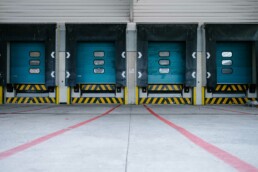
Federal Maritime Commission (FMC)
Percent furloughed: 94%
In the case of a government shutdown, the Federal Maritime Commission (FMC) would face a significant challenge, with 94% of its workforce furloughed. This independent agency, responsible for overseeing container shipping competition in the U.S., plays a crucial role in ensuring a competitive and reliable international ocean transportation supply chain. During a shutdown, most of FMC’s operations would cease, affecting shippers and carriers involved in the container trades. Activities such as filing applications, license requests, and agreement reports would be put on hold.
Federal Railroad Administration (FRA)
Percent furloughed: 35%
The Federal Railroad Administration (FRA), responsible for railroad safety oversight, would experience a partial shutdown with 35% of its workforce furloughed. During this time, safety rulemakings unrelated to FRA’s financial assistance programs would be delayed. This delay could be concerning, especially in the context of safety rulemakings following incidents such as the East Palestine, Ohio, train derailment in February.
U.S. Coast Guard
Percent furloughed: 13%
The U.S. Coast Guard (USCG), responsible for vessel safety and port security, would continue most of its functions with only 13% of its workforce furloughed. However, as the USCG is part of the Department of Homeland Security, its service members would go without pay during a shutdown, potentially impacting morale.
Surface Transportation Board (STB)
Percent furloughed: 99%
In the event of a government shutdown, the Surface Transportation Board (STB), which regulates and monitors competition among U.S. freight railroads, would face a near-complete shutdown, with 99% of its workforce furloughed. This would impact various activities, including regulatory filings, procedural schedules, and access to rail lines for shippers.
U.S. Maritime Administration (MarAd)
Percent furloughed: 24%
MarAd, responsible for regulating domestic U.S. maritime markets, would maintain most of its functions during a government shutdown. However, specific activities within MarAd’s Office of Cargo and Commercial Sealift would be suspended. This includes staff support for emergency crisis management and the approval of vessel transfers out of the U.S.-flag registry.
Customs and Border Protection (CBP)
Percent furloughed: 8%
With 92% of its employees retained during a shutdown, Customs and Border Protection (CBP) would continue its core operations, including cargo inspection at U.S. ports. However, policy, regulatory, legislative, auditing, and training activities would likely be suspended, affecting importers and potentially leading to slower clearance of shipments.
Federal Highway Administration (FHWA)
Percent furloughed: 0%
FHWA, responsible for highway infrastructure, would continue its operations without furloughs, thanks to funding from the Infrastructure Investment and Jobs Act (IIJA). However, state agencies remain concerned about funding delays potentially impacting project timelines.
Federal Motor Carrier Safety Administration (FMCSA)
Percent furloughed: 0%
The Federal Motor Carrier Safety Administration (FMCSA), regulating commercial vehicles and carriers, would continue its operations during a government shutdown. FMCSA positions are funded through various sources, ensuring that commercial vehicle regulations remain in place.
National Highway Traffic Safety Administration (NHTSA)
Percent furloughed: 0%
NHTSA, responsible for commercial vehicle safety, would maintain its functions with available multiyear funding from prior-year appropriations and supplemental appropriations. All activities and personnel funded through the Highway Trust Fund or the IIJA’s supplemental appropriations would continue.
Environmental Protection Agency (EPA)
Percent furloughed: 93%
EPA is expected to maintain most of its core functions during a government shutdown, with 93% of its workforce retained. However, approvals for state requests, including EPA environmental permits for freight-related infrastructure projects, could face suspension.
The Impact of Shipping and Delivery on E-commerce Satisfaction
In the evolving world of e-commerce, customer satisfaction hinges not only on product quality and price but also on the efficiency and reliability of shipping and delivery services. Understanding the significance of these factors is crucial in enticing potential e-commerce leads. In this blog, we delve into the key takeaways from a recent survey regarding shipping and delivery experiences, and how these findings can shape your approach to enticing e-commerce businesses.
Read More…
A government shutdown has the potential to disrupt the intricate web of agencies that play a crucial role in the logistics and fulfillment industry. As Falcon Fulfillment strives to maintain the efficiency and reliability of its supply chain operations, it’s imperative to remain vigilant and adaptable in the face of such challenges.
The logistics and fulfillment sector, often regarded as a backbone of the U.S. economy, relies heavily on the seamless movement of goods. Any interruptions caused by a government shutdown can ripple through the supply chain, affecting businesses, manufacturers, retailers, and ultimately, consumers.
To mitigate the impact of a potential shutdown, businesses should consider contingency plans. This might include diversifying transportation and warehousing options, ensuring clear communication with partners and clients, and staying abreast of regulatory changes. Additionally, building resilient supply chains that can withstand disruptions, whether from government actions or other unforeseen events, is a strategic imperative.
Contact Falcon Fulfillment today to get more information on supply chains and fulfillment and discover how our 3PL services can help protect your supply chain and logistics management.
Let’s Talk!
Beginner’s Guide to Third-Party Logistics (3PL)
Unlocking the Potential of Third-Party Logistics (3PL)
A Beginner’s guide to third-party logistics (3PL)
The world of e-commerce is always changing, understanding the roll of Third-Party Logistics is integral to keeping up. This beginner’s guide to third-party logistics (3PL) will delve into the essential aspects, offering insights into fulfillment services, warehousing, and much more.
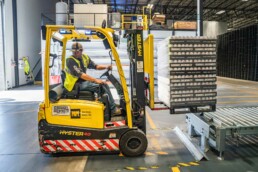
What is Third-Party Logistics (3PL)?
Third-Party Logistics, often abbreviated as 3PL, is a strategic partnership between e-commerce companies and specialized logistics providers. It encompasses a wide array of services, from warehousing and distribution to order fulfillment solutions.
Fulfillment Services
At its core, 3PL companies provide invaluable fulfillment services, ensuring that orders are processed efficiently and shipped to customers promptly. This service streamlines the entire order fulfillment process, allowing e-commerce businesses to focus on their core competencies.
Warehousing and Distribution
Warehousing and distribution are the backbone of any 3PL operation. These providers maintain state-of-the-art warehouses strategically located for efficient product storage and quick shipping. Inventory management is a critical aspect, ensuring products are readily available when customers place orders.
Inventory Management
Effective inventory management is vital to prevent stockouts and overstock situations. 3PL providers excel in optimizing inventory levels, reducing carrying costs, and ensuring products are available when needed.
Shipping and Delivery
The efficiency of shipping and delivery is where 3PL providers shine. They offer a wide range of options, including last-mile delivery, same-day, and next-day delivery. This ensures that customers receive their orders quickly, enhancing the overall shopping experience.
Supply Chain Management
3PL providers also play a significant role in supply chain management. They handle tasks such as cross-docking, freight forwarding, and even reverse logistics, ensuring a seamless flow of goods through the supply chain.
Value-Added Services (VAS)
To stay competitive, many 3PL providers offer value-added services like kitting and assembly, customs brokerage, and even dropshipping solutions. These services cater to the unique needs of e-commerce businesses.
Technology Solutions
In today’s digital age, 3PL providers leverage technology to enhance their services. They utilize Transportation Management Systems (TMS), cloud-based Warehouse Management Systems (WMS), and inventory tracking software to provide accurate, real-time information.
Scalable Fulfillment Solutions
One of the key advantages of 3PL is scalability. As your e-commerce business grows, 3PL providers can adapt to your changing needs, ensuring your logistics operations remain efficient and cost-effective.
When Is It Time to Switch Your Fulfillment Provider?
Your fulfillment provider is an important partner in your business. They help you get your products to your customers quickly and efficiently, which can have a big impact on your bottom line. But what if your current fulfillment provider isn’t meeting your needs? We will help you answer the question: Is It Time for a Fulfillment Provider Switch?
Third-Party Logistics (3PL) is a vital partner for e-commerce businesses seeking to streamline their operations and provide exceptional service to customers. This beginner’s guide has introduced you to the world of 3PL, covering fulfillment services, warehousing, technology solutions, and more.
By harnessing the expertise of 3PL providers, e-commerce companies can optimize their supply chains, improve order accuracy, and enhance customer satisfaction. As you explore the world of e-commerce, remember that 3PL can be your trusted ally on the path to success.
If you’re ready to start the transition or have questions, contact us to learn more about our services.
Let’s Talk!
Case Study: SOLE - Pioneering Sustainability in the Footwear Industry
Since SOLE launched in 2001 they’ve known that, like any major industry, footwear comes at a massive environmental cost. They’re determined to innovate ways to mitigate and reverse that environmental impact. To do so they turned to a natural, sustainable material that’s unlike any other: natural cork. Join us in this SOLE Footwear Case Study and see how SOLE and Falcon Fulfillment stepped it up!
SOLE was founded by Mike Baker, who started the company after experiencing back pain from his previous career as a salesman. Legend has it, he recognized the potential of insoles to provide foot support and alleviate pain through the comfort he felt walking on cork flooring at a friends house. From there ‘ReCORK‘ was born.
Key Metrics
-
131,989,095 corks collected through the ReCORK program, and counting.
-
8,097 cork oak trees planted in 2013.
-
Over eighteen million satisfied soles.
SOLE Footwear Case Study: Pioneering Sustainability in the Footwear Industry
In 2001 Mike Baker was having some back problems and started investigating insoles and realized that he could probably do something in that industry. He researched it and basically came up with the first SOLE footbed.

How did SOLE get started?
The company embarked on its journey by creating the first SOLE footbed, which rapidly gained popularity thanks to its custom moldable design, exceptional arch support, and pain relief capabilities. Following that, SOLE extended its product range to encompass cork-based footbeds, flips, and closed-toe footwear.
“We’re the original custom moldable since 2001 and it really took off and we’ve been growing ever since from there.”
Andrew Yule, VP Operations – SOLE
When SOLE first developed their footbeds, it was important to them that they offer more than simple comfort. They needed to be comfortable of course, but they also need to be truly effective at reducing pain and fatigue.
Through an ongoing partnership with Dr. Reed Ferber and the Running Injury Clinic, they’ve been able to help fund studies of the effectiveness of insoles on injury prevention and performance.
SOLE products are effective, long lasting, and have very high customer satisfaction. Time and again, SOLE has proven to be the best over-the-counter orthotic on the market.
What sets SOLE apart?
“I think it really comes down to Mike’s willingness to push the envelope. He doesn’t want to follow trends; he wants to lead them. You’re always starting something new, doing things that nobody else has tried before, blazing a trail.”
Andrew Yule, VP Operations – SOLE
SOLE distinguishes itself as more than just a typical over-the-counter insole. They proudly showcase premium quality and the dynamic shape of their footbeds, which feature the DPO cup, high arch, and density mapping for effective foot issue resolution. Under Mike’s vision and the company’s lean and scrappy nature, they fearlessly push boundaries, consistently innovate, and pave new paths. This perpetual startup mentality empowers them to experiment with fresh ideas, including trailblazing a recycled cork supply chain.
Their belief in the transformative power of their footbeds drives their success. These footbeds provide relief and comfort to customers, rewarded with a 90-day guarantee and personalized service. SOLE’s marketing strategy targets a broader audience through sales, promotions, and leveraging Amazon’s platform. Their upcoming shoe line exemplifies their commitment to sustainability. It incorporates bison shield insulation and eco-friendly sourced wool. In a competitive industry, SOLE stands out as a trailblazer. They lead with unique and sustainable footwear solutions.

Significant Milestones
SOLE has recently achieved several significant milestones, showcasing their commitment to innovation and sustainability. They recently securing a patent for their groundbreaking cork formulation in Portugal, where their research and development facility for cork is located. Portugal’s reputation as the cork capital of the world makes it an ideal location for such advancements. Additionally, SOLE has taken a monumental step towards eco-friendliness by transitioning all their packaging to be plastic-free, marking a significant change in their business practices.
“Another milestone is the number of corks collected, and it was 130 million. We’re working towards a circularity program to give cork a second and even a third life.”
Andrew Yule, VP Operations – SOLE
SOLE Footwear Case Study: Pioneering Sustainability in the Footwear Industry
SOLE has also made great strides in their recycling initiative, collecting a remarkable 130 million corks from all over North America, diverting them from landfills and giving them a new purpose in their innovative footwear. The company is actively working towards achieving circularity, aiming to extend the life cycles of cork products to minimize waste and environmental impact. In 2022, SOLE’s impact was emphasized by producing an impressive 8.5 million pairs of footbeds, underscoring their widespread adoption and popularity.
Finding your SOLE at Falcon
The pandemic put SOLE in the position to reevaluate their in-house shipping process.
“The difference that sets Falcon apart is really the collaboration that they are willing to do. With other organizations, it was like you fit into their system, whereas the Falcon model was, “Let’s collaborate and get our systems to work together”. That was a huge change from what we’ve experienced in the past and has really restored our belief in 3PL’s.”
Andrew Yule, VP Operations – SOLE
SOLE had started with their own fulfillment setup but the pandemic made them realize changes needed to be made. The challenges and triggers that prompted SOLE to start the fulfillment partner search were a need to reduce overheads costs and previous unsatisfactory experiences with other 3PLs.
Moving from one partner to another wasn’t seamless, and the lack of collaboration in previous setups was a major hurdle. However, when they connected with Falcon, everything changed. The collaboration and willingness to work together to integrate their systems made a significant difference. Falcon’s responsiveness, professionalism, and commitment to building a strong relationship were exceptional. Switching to Falcon took less than a month, and SOLE was supported through the troubleshooting process, making the transition during a pandemic much smoother than anticipated. It has been a highlight of their company history to work with such a willing and reliable partner, and their fulfillment process now runs seamlessly in the background as it should.

“My focus as an outbound manager is on the relationships with my 3pl and I’d have to say from day one Falcon was very open to having weekly conversations, more if needed, right at the beginning we’re having a lot more conversations. When I send an email I get a response in an hour or less, very responsive, it’s very professional.”
Kaila Burke, Outbound and Distribution Operations Manager – SOLE
Passing the Culture Test
In any partnership, cultural alignment is crucial. Falcon demonstrated a willingness to embrace aspects of SOLE’s culture, such as switching to paper tape for packaging. This adaptability and understanding made SOLE feel valued and heard, fostering a sense of comfort in the partnership.
In the collaboration between SOLE and Falcon, the winning dynamic that stood out is the establishment of a relationship that fosters trust, accountability, and open communication. Falcon relies heavily on their dedicated Account Managers which provide unparalleled contact for customers like SOLE. This partnership allowed for better communication and a more transparent exchange of information, enabling both sides to share valuable insights and ideas openly.
The foundation of Falcon’s success with SOLE is built upon top-down accountability, starting with Kipp, Falcon’s CEO/President. Kipp’s approachable and no-nonsense demeanor coupled with an open-door policy, encouraging everyone to express their opinions and concerns without fear of retribution. This supportive leadership style enables a culture where employees are empowered to take ownership of their work and contribute meaningfully to the company’s success which directly supports the mission of satisfying the customer.


Next Steps
SOLE introduces the Jasper Chukka, their latest sustainable innovation, show casing their pioneering cork technology. This shoe masterfully blends style, comfort, and eco-consciousness by utilizing cork, a renewable and eco-friendly material. In a strong display of commitment, SOLE partners with their sustainability brand, ReCORK, actively reducing carbon footprints. The impending release of the Jasper Chukka represents a remarkable milestone for both brands.
The upcoming launch of their revolutionary Jasper Chukkas stands as the most anticipated step. This shoe boasts a groundbreaking natural cork midsole, a response to the surging demand for sustainable footwear. It’s a move that cements SOLE’s role as a trailblazer, leading the way in meeting environmental expectations.
The Right Fit
The smooth transition and the seamless fulfillment of orders left a lasting impression on SOLE, marking it as one of the highlights of the relationship. The willing and supportive approach from Falcon made the transition a success and cemented the partnership.
“At this point in the game, we feel incredibly comfortable with Falcon as our fulfillment partner. They are like a reliable backstop for us, always there to support us when it comes to fulfillment. It’s impressive that the issues we faced in the past have not recurred in quite a long time. Everything is running incredibly smoothly, and that’s all we could ask for from a 3PL. We have confidence in Falcon, and they have truly earned our trust.”
Andrew Yule, VP Operations – SOLE
All images courtesy of SOLE
Learn more
Boost your e-commerce business by finding a better order fulfillment partner.
See if Falcon Fulfillment is the best fit for your brand.
E-commerce Post-Pandemic Retail: Strategies for Success
E-commerce Post-Pandemic Retail
The pandemic has reshaped consumer behavior in unprecedented ways, triggering a rapid transformation in the retail industry. Within the 3PL/fulfillment industry, the crucial role that e-commerce plays in today’s market is evident. In this blog, we will examine how e-commerce fits into the post-pandemic retail landscape and discuss strategies for success.
The Shift in Consumer Behavior
The EY Future Consumer Index reveals that 80% of U.S. consumers are still altering their shopping habits, with 60% visiting physical stores less frequently than before the pandemic. Notably, 43% of consumers have increased their online shopping for products they previously bought in brick-and-mortar stores. This shift underscores the diminishing significance of geographical location, as long as there’s an internet connection.
E-commerce: A Lifeline in Crisis
The pandemic catalyzed a remarkable change in the prioritization of e-commerce. Retailers, recognizing the importance of digital channels, invested approximately $10 billion in e-commerce initiatives between May and July 2020. These investments ranged from enhancing logistics for last-mile delivery to exploring asset-light approaches such as ghost kitchens and dark stores. Additionally, retailers embraced digital capabilities in AI and blockchain.
Thinking Beyond E-commerce Investments
To thrive in the e-commerce landscape, retailers must shift their focus from asking what e-commerce investments are required to creating a profound consumer experience. This shift represents a cultural change for many retailers rooted in traditional brick-and-mortar thinking. The key is to build a consumer journey based on deep, enriching relationships rather than mere transactions.
Balancing Online and In-Person Shopping
The future of retail necessitates an integrated consumer journey, where online and in-person shopping complements each other. As consumers seek social interaction post-pandemic, retailers should consider how to merge the online and offline experiences seamlessly. The EY Index reports that 38% of consumers plan to continue shopping online while visiting stores that offer exceptional experiences.
Key Questions for Retailers
Retailers must address several critical questions when defining their investment and operating models:
- Do I possess an agile, adaptive technology platform that caters to diverse consumer journeys?
- Is my organizational structure free from silos that disrupt the consumer experience?
- Have I harmonized my online and in-store assortments strategically?
- How can I remain price-competitive while ensuring a seamless online shopping experience?
- What strategies can I employ to orchestrate a smooth transition between digital and physical shopping?
- How can I maintain a superior experience all the way to the consumers’ doorsteps?
The Crucial Role of Last-Mile Delivery
In e-commerce success, the last mile is paramount. Consumers today demand accessibility, affordability, and convenience. The EY Index indicates that only 21% of U.S. consumers are forgiving when it comes to service disruptions due to Covid-19. Retailers must excel in the last mile, as it has become a cornerstone of the e-commerce experience.
The Store as a Fulfillment Center
Many consumers now prefer online orders with in-store pickup. However, retailers must ensure that this experience is seamless, with efficient inventory management and minimal wait times. Effective communication between business units is crucial as this service scales.
The Impact of Shipping and Delivery on E-commerce Satisfaction
In the evolving world of e-commerce, customer satisfaction hinges not only on product quality and price but also on the efficiency and reliability of shipping and delivery services. Understanding the significance of these factors is crucial in enticing potential e-commerce leads. In this blog, we delve into the key takeaways from a recent survey regarding shipping and delivery experiences, and how these findings can shape your approach to enticing e-commerce businesses.
E-commerce’s role in the post-pandemic world is central to the retail industry’s survival and growth. As consumer behavior continues to evolve, retailers must focus on creating holistic, enriching experiences that bridge the digital and physical realms. Success in this new landscape depends on adaptability, innovation, and a commitment to delivering exceptional service. Stay tuned to Falcon Fulfillment for more insights into the dynamic world of e-commerce and 3PL/fulfillment services.
Looking for a fulfillment solution that will help you stay on top and scale?
Let’s Talk!
Strategies for Success During Economic Downturns: Part 2
Success During Economic Downturns
The impact of economic uncertainty is palpable, affecting individuals and businesses alike. For business owners, this uncertainty can be especially worrisome. During times of economic hardship, companies encounter distinct hurdles that demand creative approaches to not only survive but thrive. Explore how these solutions during economic downturns can serve as a compass to guide you through challenging terrain and ensure the success of your business.
This week we will cover lease challenges, remote trends, and employee retention.

Navigating Commercial Lease Challenges
Economic downturns prompt businesses to rethink commercial lease agreements. Discover strategies to optimize lease terms:
1. Strategic Negotiations: Engage landlords to explore mutually beneficial lease adjustments, potentially offering lease extensions in exchange for reduced rates.
2. Space Optimization: Consider downsizing your office space to cut costs and embrace remote work trends, potentially enhancing collaboration through coworking. Maybe you are using more space than you need. Offloading some of your process through fulfillment can save you money as well as time.
3. Subleasing Opportunities: Explore subletting options to offset lease costs, ensuring careful selection of subtenants and compliance with lease terms.

Adapting to Remote Work Trends
Embracing remote work can offer cost-saving advantages during economic downturns. Explore effective ways to transition toward a more flexible work setup:
1. Remote Work Advantages: Consider transitioning to smaller office spaces to accommodate remote work, reducing overhead costs and attracting talent.
2. Coworking Dynamics: Embrace coworking to promote collaboration and optimize space usage, potentially lowering infrastructure expenses.

Employee Retention Strategies
Retaining talented employees during tough economic times is crucial. Discover innovative approaches to prevent layoffs and maintain a motivated workforce:
1. Enhanced Benefits: Offer extended vacation time or a four-day workweek to entice employees and trim payroll costs.
2. Targeted Workforce Reduction: Make informed decisions about staff reductions based on performance metrics, ensuring retention of top performers.
3. Severance Agreements: Formalize employee departures with severance agreements to clarify responsibilities and protect both parties’ interests.
Missed Part 1?
Strategies for Success During Economic Downturns: Part 1
Everyone is feeling it, the rough waters of economic uncertainty. As a business owner this is particularly fretful. In times of economic difficulty, businesses face unique challenges that require innovative strategies to thrive. Discover how utilizing fulfillment during economic downturns can help you navigate tough landscapes and secure your business’s success.
Utilizing fulfillment strategies in times of economic uncertainty becomes a crucial factor for companies aiming to establish stability and drive expansion. By embracing these specialized recommendations, one can effectively address obstacles and emerge more resilient in challenging circumstances. For personalized advice on enhancing your business’s fulfillment methods, consider reaching out to the professionals at Falcon Fulfillment.
Contact Falcon Fulfillment and together we can navigate the downturn and help you grow!
Let’s Talk!
Strategies for Success During Economic Downturns: Part 1
Success During Economic Downturns
Everyone is feeling it, the rough waters of economic uncertainty. As a business owner this is particularly fretful. In times of economic difficulty, businesses face unique challenges that require innovative strategies to thrive. Discover ways to improve your bottom line and how utilizing fulfillment during economic downturns can help you navigate tough landscapes and secure your business’s success.
This week we will cover inflation, cost cutting, and service contracts.
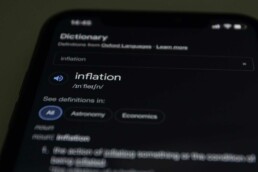
How to Strengthen Your Business Amid Inflation
Small businesses often bear the brunt of rising costs and diminishing consumer confidence during inflation. This guide equips you with essential insights to safeguard your business:
1. Optimal Pricing Strategies: Navigate price hikes without losing customers by assessing recent material and service costs, finding the balance between profitability and customer satisfaction. Fulfillment is approximately 15% of your product cost, be sure you are getting the best band for your fulfillment buck.
2. Gradual Price Adjustments: Implement step-by-step rate increases to acclimate clients to changes, mitigating sticker shock and maintaining steady profits.
3. Diversification: Consider expanding your product or service offerings to attract new clientele, bolstering short-term income and long-term growth.

Cutting Costs Without Compromising Quality
Cost reduction becomes imperative for businesses facing shrinking profit margins. Explore effective methods to lower expenses while preserving quality:
1. Smart Cost Cutting: Identify areas to trim expenses without sacrificing quality, such as sourcing more affordable suppliers or negotiating better deals with vendors. Regarding fulfillment, be sure the rates you are getting and the level of service is competitive. Need a rate check? Ask us!
2. Economical Procurement: Purchase supplies in larger quantities to avail bulk discounts, and explore energy-saving measures to cut production costs.
3. Strategic Workforce Management: Optimize workforce efficiency, explore outsourcing options, or consider role realignment to reduce labor expenses.
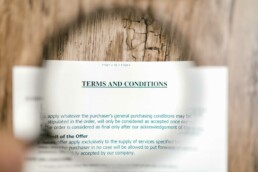
Optimizing Service Contracts for Stability
Service contracts can significantly impact your business’s bottom line. Learn how to make informed decisions about renewing, reworking, or ending contracts:
1. Data-Driven Choices: Analyze service usage patterns to determine contracts worth renewing based on cost-effectiveness and equipment condition.
2. Contract Modification: Negotiate contract terms to align with changing business needs, potentially securing lower costs while maintaining essential services. Fulfillment is one area to focus on. Are you getting what you are paying for?
3. Effective Contract Endings: Strategically end contracts for services no longer required, redirecting resources toward critical business functions. Be sure you have your bases covered though; don’t end a contract without a successful solution in place.

Leveraging Fulfillment Companies in Navigating eCommerce Challenges
The digital revolution of eCommerce has propelled companies onto online platforms and digital marketplaces, ushering in a new era of possibilities. Despite the undeniable benefits, many distributors encounter hurdles when navigating the eCommerce terrain. This blog delves into the challenges at hand and underscores the pivotal role fulfillment companies play in surmounting these obstacles.
Leveraging fulfillment strategies during economic downturns is essential for businesses seeking stability and growth. By adopting these expert insights, you can navigate challenges and emerge stronger in the face of adversity. For tailored guidance on optimizing your business’s fulfillment approach, consult with our experts at Falcon Fulfillment.
Next week join us for part 2 where we will discuss more ways to manage your business during difficult economic times.
Contact Falcon Fulfillment and together we can navigate the downturn and help you grow!
Let’s Talk!
Global Parcel Volume Growth Slows: Trends Forecasts
Parcel Volume Growth Trends
In 2022, the momentum of global parcel volume growth faced a noticeable deceleration. This is attributed in part to China’s economic downturn and the moderation of U.S. e-commerce after its heights from the preceding year.
Slow growth from China
In 2022, the global parcel volume grew by 1%, totaling 161 billion parcels, per data from Pitney Bowes. This marked an increase from the previous year. China’s parcel volume was a meager 2% increase, marking its slowest growth rate since tracking started. Pitney Bowes’ Parcel Shipping Index revealed an intriguing statistic – 5,102 parcels shipped every second throughout the year.
The shift in China’s parcel volume can be attributed to the impact of COVID-19-related lockdowns in 2022. This slowdown in a country that was sustaining a double-digit growth rate from 2013 to 2021 raised concerns. Gregg Zegras, Executive VP of Global E-commerce at Pitney Bowes, noted, “China’s parcel volume growth trajectory has been disrupted by the pandemic’s aftermath. The world’s second-largest economy is grappling with a delicate pace of recovery, leading to reduced volume, declining e-commerce sales, and an overall economic fragility. Our projections indicate a 7% parcel volume CAGR from 2023 to 2028.”
A closer look at historical data reveals that China’s pre-pandemic parcel volume forecasts were ambitious, predicting a 25% CAGR from 2018 to 2022. The actual growth was a modest 22% CAGR during that period.

Parcel Volume Growth Patterns
The global landscape portrays varying patterns of growth. Parcel volumes that numbered 64 billion units in 2016 increased to 161 billion in the past year. India emerged as the leader, with an 18% increase fueled by e-commerce growth. Noteworthy changes were also exhibited by Italy (4%), China (2%), Australia (2%), and Brazil (2%). However, Sweden and Canada faced substantial declines, experiencing drops of –11% and –9%, respectively.
While parcel volumes exhibited an upward trajectory, revenue experienced a divergent trend in 2022, dipping by 1% to $485 billion. Pitney Bowes attributed this downturn to the strength of the U.S. dollar against other currencies. Among the nations studied, the U.S., Brazil, India, and Australia were the sole contributors to revenue growth.
Leading the chart in carrier revenue, the U.S. showcased a 7% surge, amounting to $198 billion, bolstered by a robust $9.30 per-parcel revenue. In the realm of per-parcel revenue, Canada was the frontrunner, with an impressive figure of $9.80, while France was close behind at $9.10. In stark contrast, China posted a mere $1.40 per-parcel revenue, underscoring the U.S.’s substantial revenue generation capacity.
The global landscape of parcel volume growth underwent a notable deceleration in 2022, attributed to a myriad of factors including China’s economic turbulence and the moderation of U.S. e-commerce. These insights, combined with future projections, underscore the dynamic nature of the parcel shipping industry and the evolving market forces shaping its trajectory.
Want to stay up to date with shipping news? Falcon Fulfillment is your resource!
Let’s Talk!
